Modern Feature Walls: Enhance Your Space with Style
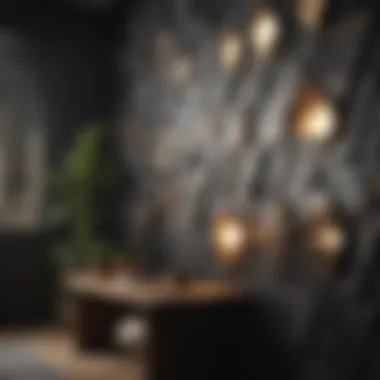
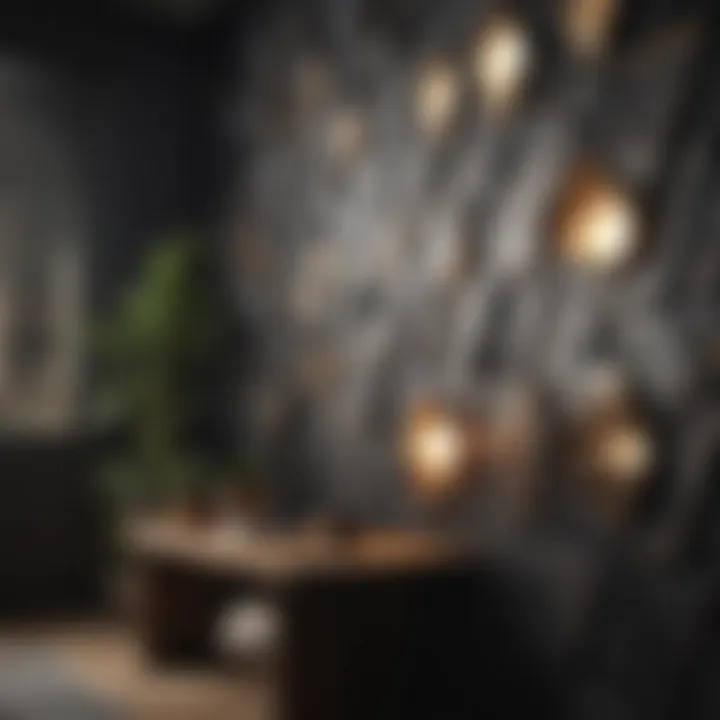
Intro
In the realm of interior design, the notion of a feature wall has evolved significantly. No longer a mere afterthought, modern feature walls occupy a central role in sophisticated spaces. They combine form and function, offering aesthetic appeal while enhancing the overall atmosphere of a room. This discussion aims to provide insight into the various aspects of modern feature walls, including popular styles, materials, and their impact on interior design.
Feature walls serve not only to create a focal point but also to reflect the personality and taste of the homeowner. As we delve into the various design inspirations, it is essential to consider current trends, color palettes, and how these elements play into the broader context of home design.
Design Inspiration
A well-crafted feature wall can transform a dull space into an engaging environment. Understanding the currents of interior design is essential for creating impactful feature walls.
Current Interior Design Trends
Today’s interior design trends lean towards minimalism, sustainability, and bold expressions of style. Some key trends shaping modern feature walls include:
- Natural Elements: The use of wood, stone, and other organic materials brings a sense of the outdoor environment into the home.
- Geometric Patterns: Sharp lines and shapes create visual interest and modernity.
- Textured Surfaces: From 3D wall panels to textured paint, adding depth is a popular approach.
- Bold Color Use: Vibrant hues are being embraced as central themes in feature wall designs.
These trends provide numerous pathways for homeowners to express unique designs. Selecting the right direction can turn a simple wall into a significant element of the decor.
Color Palettes and Their Effects
The color palette of a feature wall can dramatically influence the mood and aesthetic of a room. For example, deeper colors like navy or charcoal can evoke a sense of warmth and comfort. Conversely, lighter tones, such as pale blue or soft beige can promote a feeling of openness and serenity.
Consider these approaches when selecting colors for a feature wall:
- Monochrome: Using various shades of a single color creates a cohesive look and can amplify a sense of space.
- Contrasting Colors: Pairing complementary colors can draw attention and energize a space.
- Accent Walls: Utilizing a standout color only on one wall can serve as a great focal point without overwhelming the rest of the room.
"The color choices in interior design are not just aesthetic; they directly affect the emotions and behavior of those who occupy the space."
When combining color with design trends, the result can lead to visually stunning environments that resonate deeply with residents and guests alike.
Understanding Modern Feature Walls
The concept of modern feature walls has gained traction in interior design. It represents a shift in how spaces can be utilized for both aesthetic pleasure and functionality. Feature walls act as focal points within a room, offering a canvas that can be tailored to individual tastes and themes. They articulate the essence of a space while providing a backdrop that can enhance or define the character of a room.
In this context, understanding modern feature walls involves grasping their definition, evolution, and historical significance. Features such as materials, color schemes, and design techniques all play crucial roles in creating these impactful installations.
Definition and Evolution
Feature walls refer to one wall in a room that has a distinct design or texture compared to the other walls. This can include variations in material, color, or patterns, aimed at drawing attention and adding depth to a room. The evolution of feature walls is indicative of changing design sensibilities. In the past decades, interior design has seen a move away from uniformity; the rise of personalization has cultivated an environment where homeowners want to express themselves through their space.
Initially, feature walls were limited to a simple paint job or the application of wallpaper. Today, the embrace of diverse materials such as wood, stone, and textiles has transformed how these walls are perceived and implemented. Homeowners are now presented with a plethora of options that cater to various styles, contributing to their apparent resurgence in popularity.
Historical Context
The historical context of feature walls can be traced back to traditions in various cultures that emphasized the importance of certain walls. For example, ancient Egyptians adorned their walls with intricate art that told stories or depicted their beliefs. Similarly, in medieval Europe, grand tapestries were hung to showcase wealth and status.
In modern times, the feature wall gained prominence with the advent of contemporary design movements in the mid-20th century. Architects and designers began to realize the potential of a single wall serving as a visual anchor within a space. This led to innovative approaches such as retrofitting old spaces into modern dwellings, effectively reviving the idea of a focal wall but with contemporary materials and techniques.
In essence, modern feature walls embody a synthesis of tradition and innovation, allowing individuals to express their personal style through carefully curated designs.
The appreciation for individual expression in home décor has paved the way for a wide array of feature wall options in today’s interiors. The journey of feature walls, from past practices to present-day applications, reflects our evolving relationship with space, design, and functionality.
Materials Commonly Used
The choice of materials plays a pivotal role in defining the aesthetic and functional attributes of modern feature walls. Each type of material offers unique benefits and considerations that can significantly influence the overall appearance of a space. In today’s interior design landscape, where personalization and creativity take precedence, understanding these materials is essential for homeowners and design enthusiasts alike.
Wood Panels
Wood panels provide warmth and a sense of comfort to interiors. They come in various finishes, such as natural, stained, or painted, allowing for a wide range of design options. Wood is known for its durability and sound-absorbing properties, making it ideal for creating cozy environments, especially in living rooms and bedrooms. When choosing wood panels, consider the type of wood species, as some offer unique grain patterns and colors that can enhance the overall look.
- Benefits:
- Considerations:
- Aesthetic appeal adds warmth.
- Natural insulation helps with acoustics.
- Versatile finishes match various design themes.
- Requires maintenance to prevent fading or damage.
- Sensitive to humidity changes, which might lead to warping.
Stone and Brick
Stone and brick are timeless materials that evoke a sense of permanence and robustness. They are often used for creating striking feature walls that draw attention. Natural stone, like granite or slate, adds texture and can be used creatively to enhance the depth of a wall. Brick, while it can appear rustic, can also be finished in modern ways, like whitewashing, to suit contemporary designs. Both materials demand substantial investment but offer unmatched strength.
- Benefits:
- Considerations:
- Highly durable and long-lasting.
- Offers unique textures and visual interest.
- Low maintenance compared to some other materials.
- Installation can be labor-intensive.
- Weight may need structural consideration for walls.
Paint and Wallpaper
Paint and wallpaper are the most accessible options for homeowners looking to create feature walls. With a vast array of colors and patterns, they provide flexibility in design. Paint can easily alter the mood of a room, while wallpaper can add intricate designs that are hard to replicate with other materials. Using paint or wallpaper means easy updates for seasonal changes or personal preferences.
- Benefits:
- Considerations:
- Cost-effective and quick to apply.
- Variety of colors and textures available.
- Easy to change regularly.
- Some wallpapers may require professional installation.
- Paint may require touch-ups over time to maintain appearance.
Textiles and Fabrics
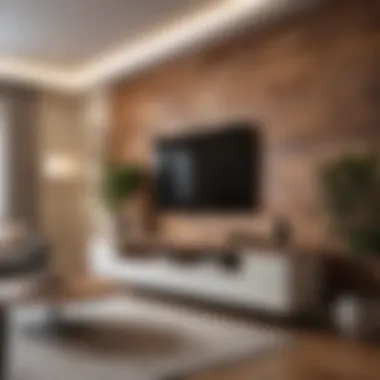
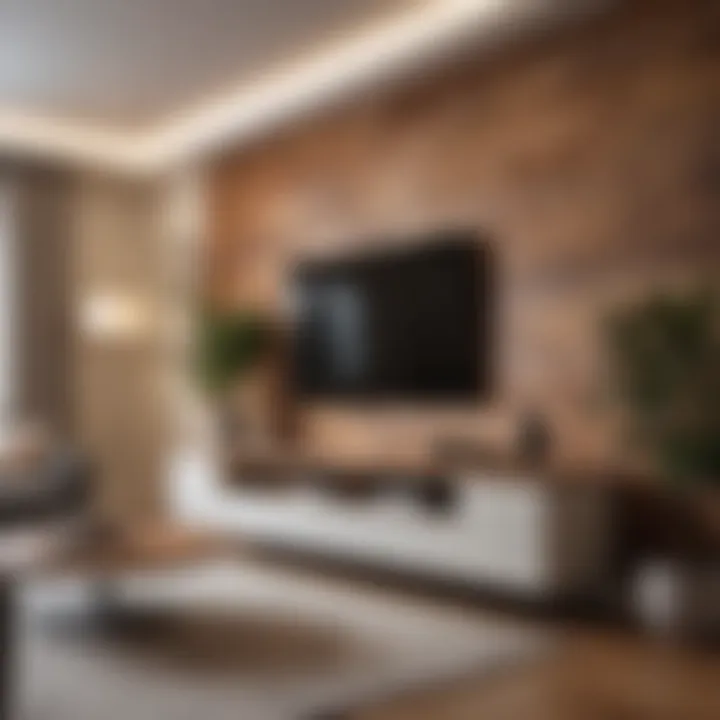
Incorporating textiles and fabrics for feature walls can introduce softness and a layered aesthetic. Fabric wall coverings or even hanging tapestries can provide a cozy atmosphere. They absorb sound, which enhances the comfort level of a room. Moreover, the variety of prints and textures available allows for unique expressions of personal style.
- Benefits:
- Considerations:
- Adds a tactile dimension to interiors.
- Sound-absorbing qualities contribute to noise reduction.
- Availability in a wide range of patterns and colors.
- May attract dust and require regular cleaning.
- Potential durability issues depending on the fabric type.
Design Techniques for Feature Walls
Understanding the various design techniques for feature walls is essential for anyone looking to enhance their living space. These techniques can dramatically change how a room feels and functions. They offer a mix of practicality and aesthetics, allowing homeowners to express their personalities while optimizing their environments. With proper execution, design techniques can add depth, visual interest, and even improved acoustics to a room. It’s important to consider factors such as existing decor, room purpose, and personal style when choosing the right approach.
Accent Walls
Accent walls stand out in a room by utilizing color, pattern, or material different from the surrounding walls. Typically, one wall is highlighted to create a focal point. Homeowners might choose bold colors or unique materials like reclaimed wood or decorative wallpaper for this purpose.
Benefits of accent walls include:
- Creating a focal point: This draws attention and gives a defined character to the room.
- Versatility: Different colors and materials option can match or contrast with surrounding elements, adding depth.
- Cost-effective: Instead of redoing the entire room, an accent wall can revitalize a space without excessive expense.
Considerations include light sources and the color palette to ensure harmony within the space. Picking the right wall for accents is crucial, usually selecting a wall that catches the eye first.
Paneling Styles
Paneling styles offer another dimension to feature walls. Various materials, including wood, metal, and even MDF can create structured designs that elevate a room's style.
Key aspects of paneling include:
- Classic appeal: Wood paneling offers a timeless charm that can suit various interior designs.
- Modern twists: Some opt for contemporary materials with clean lines that blend seamlessly into modern aesthetics.
- Acoustic benefits: Thicker panels can absorb sound, leading to a quieter environment.
Paneling can be installed in various designs, such as vertical or horizontal layouts, and can include elements like molding to enhance details. Therefore, it's vital to match paneling styles with the room's intended use and overall theme.
Textured Finishes
Textured finishes can add depth and character to feature walls. From rough surfaces to smooth finishes, texture impacts how a wall is perceived - giving it a tactile quality that can intrigue and engage.
Consider types of textured finishes:
- Stucco: This offers an earthy visual touch popular in eclectic or Mediterranean designs.
- Plaster: Smooth plaster finishes create a refined look, often used in modern or minimalist settings.
- Wallpaper with texture: Textured wallpapers may include raised patterns that provide a more dynamic visual canvas.
The choice of texture influences light reflection, which can affect a room's ambiance significantly. Proper lighting techniques should be applied to highlight these textures, leading to a stunning visual effect.
Feature walls are not just aesthetic; they redefine spaces functionally, showcasing how design can be both art and utility.
Color Schemes for Feature Walls
Color schemes for feature walls play a crucial role in interior design. They can dictate the mood and character of a space. It goes beyond mere aesthetics. The right color can enhance light, create contrasts, and even influence perceived size of a room. Homeowners, therefore, must consider how color schemes align with their overall design goals.
Selecting a color scheme requires a nuanced approach. Variations in color can evoke different feelings. Warm tones give a sense of coziness, while cooler tones can create a more expansive feel. Beyond emotion, colors must coordinate with furniture and decor. This adds coherence to the room. Thus, understanding color theory is beneficial. Homeowners can select hues that complement each other, making their feature wall truly stand out.
"Using color wisely on a feature wall transforms the space, creating dynamics that reflect the homeowner's personality."
Using Bold Hues
Bold hues can make a significant statement. They draw attention and can become the focal point of a room. When carefully chosen, vivid colors create an energetic feel. For instance, a rich red can inject warmth into a living room, making it inviting. Blue could evoke tranquility in a bedroom. However, employing bold hues requires consideration of the overall room ambiance.
Benefits of bold hues:
- Focal Point: A bold wall attracts attention, breaking monotony.
- Personality: Mirrors the homeowner’s style, allowing for individual expression.
- Versatile Backdrop: Pairs well with various furniture styles.
Neutral vs. Bright
When choosing between neutral and bright colors, homeowners must weigh the advantages of both. Neutral colors offer flexibility. They create a calm environment and easily adapt to different decor styles. White, beige, or gray can enhance light and make spaces appear larger.
Bright colors, on the other hand, bring energy and vibrancy. They are ideal for spaces meant for social interactions, like living or dining areas. However, balancing bright colors with neutral elements can create harmony in the design. A bright accent wall paired with neutrally colored furnishings offers a balanced approach. The trick lies in achieving that equilibrium.
Considerations for color choices:
- Lighting: How sunlight hits the color influences its appearance.
- Room Size: Dark or bold colors can make spaces feel smaller.
- Existing Decor: Colors must enhance, not clash with furniture and art.
Trends in Modern Feature Walls
The concept of feature walls has evolved significantly in recent years. Homeowners and designers alike are recognizing their importance in setting the tone of a space. Trends in modern feature walls not only showcase aesthetic appeal but also offer practical benefits. For one, these designs create focal points that draw the eye, allowing for clearer space definition. Moreover, they provide opportunities to express personal style through various means.
People now seek sustainable and innovative materials for feature walls. This trend reflects a growing awareness of environmental impact. Features like geometric designs, nature-inspired elements, and multifunctional spaces highlight these preferences. Understanding these trends is vital for those wanting to make informed design decisions in their homes.
Geometric Designs
Geometric designs have gained popularity due to their clean lines and contemporary feel. They come in various forms, such as patterns created with paint, wood, or wallpaper. This approach adds depth and dimension to a wall, making it a statement piece in any room. The versatility of geometric shapes allows homeowners to tailor the design to their style and the function of the space.
Aside from aesthetics, geometric designs also offer practical benefits. They can enhance the spatial perception of a room. For example, sharp angles can make a small room appear larger or more dynamic, while softer curves can create a sense of comfort. Additionally, geometric patterns can easily blend or contrast with existing furniture, allowing for flexibility in design.
Nature-Inspired Elements
Incorporating nature into interior design is another trend influencing feature walls. Natural materials like wood and stone evoke a sense of calm and offer a retreat from the fast-paced environment outside. Feature walls inspired by natural elements can include moss, plant installations, or even wall art depicting landscapes. This trend not only beautifies the space but also fosters a connection to the outdoors.
Moreover, these natural-inspired walls contribute to well-being. Studies show that exposure to nature can reduce stress and anxiety. Homeowners looking to create serene environments are drawn to such designs. They seamlessly combine style with functionality, making them a valuable addition to any room.
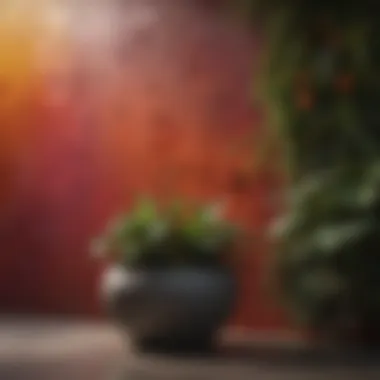
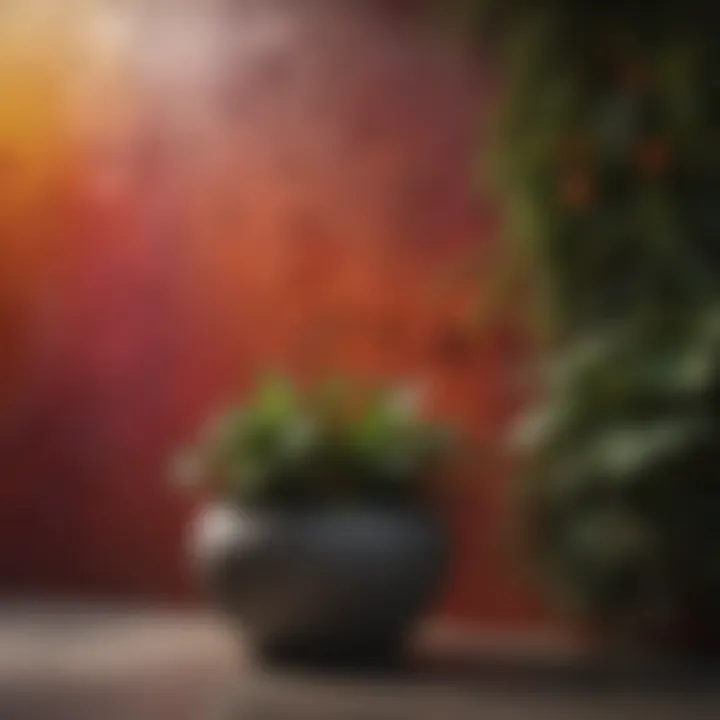
Multifunctional Spaces
The rise of multifunctional spaces in homes influences the design of feature walls. With the growing trend toward minimalism and efficient use of space, feature walls can serve various purposes. For instance, a wall can be designed to include built-in shelving, creating storage while enhancing visual appeal. This trend is particularly relevant for small apartments or homes where every inch counts.
Furthermore, multifunctional feature walls can facilitate transitions between different areas of a room. They can visually separate workspaces from relaxation zones while maintaining an open feel. By integrating technology, like wall-mounted screens or smart home features, these spaces become even more adaptable to the needs of modern living.
"Modern feature walls are not just about beauty; they reflect a deeper understanding of how we live and interact with our spaces."
In summary, trends in modern feature walls highlight a shift towards thoughtful integration of style, practical applications, and sustainable practices. Whether opting for geometric designs, nature-inspired elements, or multifunctional concepts, these walls dramatically alter the dynamics of a room, catering to the unique needs and aspirations of homeowners today.
Incorporating Feature Walls in Various Rooms
Understanding how to incorporate feature walls into different rooms is vital for achieving a cohesive and stylish home design. Feature walls can become focal points within various spaces, enhancing the overall aesthetic and functionality. When designed thoughtfully, they can transform not just the look but also the feel of a room, providing character and depth. Here, we explore applications across key areas of a home.
Living Room Applications
The living room is often the heart of the home. Incorporating a feature wall in this space can elevate its ambiance and serve as a conversation starter. Design choices may include using bold wallpaper, a gallery of framed pictures, or a unique paint color that contrasts with the remaining walls. Wood paneling or a stone accent wall can also add texture and warmth.
Key benefits:
- Creates a focal point for the room.
- Enhances the overall atmosphere.
- Allows for artistic expression through pictures or wall art.
Considerations:
- Ensure the design complements existing furnishings.
- Pay attention to lighting, as this can impact color perception.
- Aim for balance; a busy wall may require more subdued decor elsewhere.
Bedroom Ideas
In the bedroom, a feature wall can create a serene and inviting atmosphere. Soft colors or calming patterns are popular choices. Alternatively, a statement wall can provide a dramatic impact. Consider a textured wallpaper behind the bed or a painted wall with subtle designs. This practice not only adds interest but can also enhance relaxation and comfort.
Key benefits:
- Sets a peaceful and personal tone for the room.
- Offers a chance to explore unique patterns and textures.
Considerations:
- Think about how the colors affect mood, especially vibrant vs. muted tones.
- Choose materials that promote tranquility and relaxation.
Kitchen and Dining Areas
The kitchen and dining areas are spaces where family and friends gather. A feature wall here adds flair and can exhibit culinary creativity. Options include tile backsplashes, painted boards, or open shelving displaying cookbooks or decorative items.
Key benefits:
- Encourages interaction and conversation.
- Reflects personal style and taste in culinary arts.
Considerations:
- Select durable materials that withstand cooking splashes and heat.
- Create a connection between the dining space and the kitchen for a cohesive feel.
Home Office Inspirations
In a home office, the right feature wall can stimulate productivity and positive energy. Use imagery or a color scheme that inspires creativity. Consider a whiteboard wall for brainstorming ideas or a textured wall to increase focus.
Key benefits:
- Enhances focus and motivation.
- Allows for personalization related to work interests.
Considerations:
- Ensure the design remains professional if clients will visit.
- Choose colors conducive to concentration, such as blues or greens.
Installing a Feature Wall
The installation of a feature wall is a crucial aspect of transforming a living space. This process goes beyond mere aesthetics; it can significantly enhance the functionality and atmosphere of a room. A well-executed feature wall can act as a focal point, drawing attention and creating a sense of depth. Importantly, it can also help structure the layout of a space, making it feel more cohesive.
When planning to install a feature wall, there are several considerations to keep in mind. The choice of materials, design elements, and colors must complement the overall style of the home. Furthermore, proper preparation and execution are vital to achieving a polished look. This section delves into the key steps necessary for a successful installation.
Preparation Steps
Preparation is foundational to the success of installing a feature wall. First, assess the space where the feature wall will be located. This involves observing lighting conditions, surrounding decor, and the overall design theme.
Next, clear the area of furniture and other obstacles. This step ensures safety and allows enough room for movement while working. It is wise to examine the wall surface for any imperfections, such as holes or peeling paint. If issues are found, repairing them before installation will significantly improve the final outcome.
Consider creating a mood board with images and swatches of materials to visualize the desired look. Planning helps in making informed decisions, and eliminates potential mistakes during the implementation stage.
Tools and Equipment Needed
Equipping yourself with the right tools and equipment is essential for the installation process. Here is a list of items you may need:
- Level: A tor ensure straight lines and accurate placement.
- Measuring Tape: For precise measurements of the wall and materials.
- Pencil: To mark where materials will be placed without damaging the wall.
- Paintbrush and Roller: For applying paint or primer effectively.
- Utility Knife: Useful for trimming wallpaper or fabric.
- Adhesive or Nail Gun: Depending on the material, your installation method will vary.
- Safety Gear: Such as goggles and gloves to protect yourself during the work.
"Preparation is key! A thoughtful approach can significantly reduce issues during installation, leading to a much more satisfactory result."
By gathering the necessary tools and preparing the installation site, you not only set the stage for success but also ensure that the process is efficient and less stressful. With these steps in place, you're ready to transform your chosen space with a stunning feature wall.
Maintenance of Feature Walls
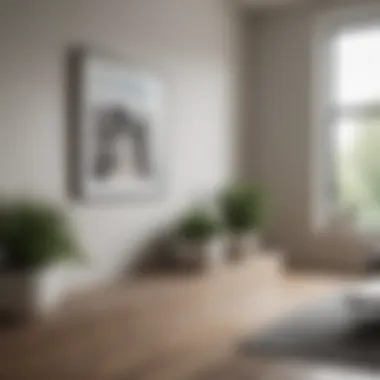
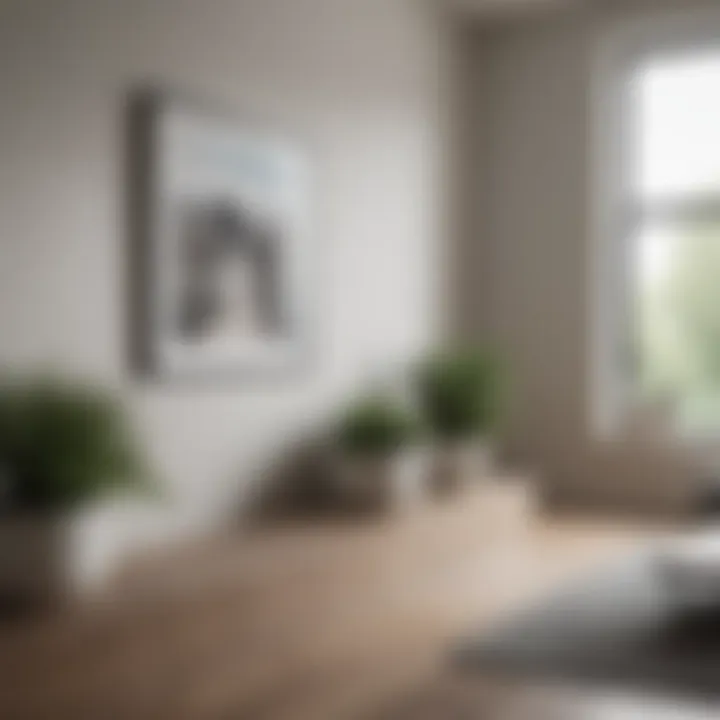
Maintaining feature walls is essential for preserving their aesthetic appeal and functional integrity. A well-kept feature wall can enhance the overall ambiance of a room, making it feel more inviting and visually impressive. Neglecting these walls, however, can lead to deterioration that affects both beauty and value of a home. Regular maintenance ensures that the materials used remain in optimal condition, preventing costly repairs and maintaining the space's allure.
Overall, the key elements of maintenance include regular cleaning and timely repairs. Homeowners must understand the specific requirements of the materials they choose for their feature walls. Different materials may require distinct approaches to cleaning or repairing, so knowledge and vigilance are critical.
Cleaning Techniques
Keeping feature walls clean is relatively straightforward, but it varies by material. For painted walls, a damp soft cloth is often sufficient. Make sure to use a mild detergent if the wall gets particularly soiled. When cleaning textured wallpaper or fabric walls, it is advisable to gently use a vacuum with a brush attachment to avoid damaging the surface.
- Wood Panels: Wipe with a damp microfiber cloth, and consider using a wood cleaner occasionally to retain its shine.
- Stone or Brick: Use a soft brush to remove dirt from joints, and rinse with water. Avoid harsh chemicals as they can damage natural materials.
- Textiles: Regular vacuuming helps to keep fabric walls fresh. Spot clean stains with appropriate fabric cleaner, or consult a professional for deeper cleaning.
It is a good practice to establish a cleaning schedule, depending on the exposure to dust and wear.
Repairing Damage
Damage to feature walls can come in various forms, such as dents, scratches, or fading. The approach to repair largely hinges on the material. For example, a scratch on a wooden panel can often be repaired with a touch-up marker or wood filler, while paint can be touched up using the original color.
- Small Holes or Dents: For drywall feature walls, use a spackle to fill holes, let it dry, and then sand lightly before repainting.
- Scratches on Wood: Light scratches can be buffed out with a soft cloth and a suitable wood polish; deeper ones may need sanding and refinishing.
- Faded Areas: Repainting or re-dyeing can restore color uniformity. It is best to do touch-ups during a planned maintenance schedule to avoid any significant mismatch.
Understanding the materials and their care can significantly extend the life of feature walls and preserve the overall quality of your interior design.
The Impact of Feature Walls on Home Value
In contemporary interior design, feature walls play a significant role in maximizing aesthetic appeal and functionality. Many homeowners recognize the value of feature walls as they not only enhance the visual interest of a room but can also substantially impact property value. By understanding this phenomenon, homeowners can make informed decisions about renovation and decoration strategies that align with market preferences.
Market Trends
The real estate market often reflects shifting trends, and feature walls are no exception. Recent years have seen an increased demand for homes featuring well-designed and strategically placed feature walls. Buyers are looking for homes that offer a unique character and a sense of individuality. Feature walls, incorporating diverse materials and creative designs, have emerged as appealing focal points in various rooms, from living spaces to bedrooms.
A key market trend is the preference for sustainable materials. With rising awareness about environmental issues, buyers are showing interest in homes that feature walls made with eco-friendly products. For example, walls adorned with reclaimed wood or painted with low-VOC paints are highly sought after. Additionally, technology-integrated feature walls, such as those featuring embedded lighting or digital art displays, are gaining popularity, making homes more attractive to tech-savvy buyers.
- Increased Interest in Customization: Homebuyers are more inclined towards spaces that offer customization opportunities. Feature walls allow buyers to envision personal adaptations that set their homes apart.
- Focus on Outdoor Connectivity: Walls that incorporate natural elements, like stone or plant walls, reflect a growing trend of connecting indoor spaces with nature, thus appealing to environmentally-conscious buyers.
Buyer Preferences
Understanding buyer preferences plays a crucial role in determining the impact of feature walls on home value. Buyers today are not only interested in aesthetics; they also prioritize functionality, sustainability, and the potential for personalization.
1. Unique Styling: Buyers often express a preference for unique designs, such as geometric patterns or artistic murals. These appeal to those seeking to convey personal taste.
2. Versatility of Materials: There is a significant appreciation for diverse materials used in feature walls. Whether it's wood, stone, or textiles, homeowners want options that resonate with their style.
3. Maintenance and Durability: Homeowners are also considering the longevity of feature wall materials. Easy maintenance options and durable finishes can influence buyer decisions.
“Buyers today are looking for homes that are not just livable but also reflections of their personal style.”
Ultimately, incorporating feature walls into a home can significantly enhance its appeal on the market. The careful selection of materials, attention to current trends, and understanding buyer preferences prime a property for greater interest and potential value increases. Homeowners should consider these elements when deciding on feature walls.
Sustainability in Feature Wall Design
The significance of sustainability in feature wall design cannot be overstated. As environmental concerns grow, homeowners and designers alike increasingly seek ways to integrate eco-friendly practices into their projects. Feature walls can significantly influence the sustainability of interior spaces, offering opportunities to use materials and methods that minimize environmental impact. This approach not only enhances aesthetic appeal but also promotes a healthier living environment.
By prioritizing sustainability, designers can create spaces that are not just visually appealing but also responsible. These walls can serve as a focal point that reflects a commitment to environmental stewardship, thus inspiring others to follow suit. In addition, incorporating sustainable design helps increase the overall value of a home by appealing to modern buyers who prioritize eco-friendly features.
Eco-Friendly Materials
When selecting materials for feature walls, eco-friendliness should be a primary consideration. Various materials are available that offer both sustainability and style. Here are some notable options:
- Reclaimed Wood: Utilizing wood that has been salvaged from old buildings or furniture reduces the demand for new lumber and minimizes waste.
- Bamboo Panels: Bamboo is a fast-growing plant that requires less water and can be harvested sustainably. Its unique look adds charm to spaces.
- Recycled Metal: Metal can be recycled indefinitely, making it a sustainable choice. Using recycled metal for feature walls can lend an industrial look while being environmentally conscious.
- Low-VOC Paints: These paints produce fewer volatile organic compounds, leading to better indoor air quality. This is essential for a healthier home environment.
By choosing any of these materials, homeowners can contribute to environmental conservation while achieving stunning visual effects in their interior spaces.
Sustainable Practices
Sustainability in feature wall design is not only about materials. The techniques and practices used during the installation and maintenance phases also play a critical role. Here are some sustainable practices to consider:
- Energy-Efficient Installation: Employing skilled craftsmen who follow energy-efficient practices during installation can lead to less waste and reduced energy consumption.
- Waste Reduction: Planning and cutting materials accurately during the installation process minimizes waste. Keeping track of measurements and using technology for better accuracy can make a difference.
- Regular Maintenance: Maintaining feature walls prevents the need for replacements, which can be resource-intensive. Simple cleaning and minor repairs extend the lifespan of materials.
- Local Sourcing: Whenever possible, sourcing materials locally cuts down on transportation emissions and supports local economies.
By implementing these practices, the environmental impact of feature wall design projects can be minimized, creating spaces that are both beautiful and sustainable.
"Sustainable design is a commitment to a healthier planet and a higher quality of life for everyone."
Ultimately, integrating sustainability into feature wall design is about more than just aesthetic appeal. It represents a commitment to future generations and the planet we inhabit. As such, homeowners and designers should consider these aspects as they plan and execute their interior spaces.
Case Studies and Examples
Case studies and examples provide concrete illustrations of how modern feature walls can be successfully implemented in various settings. They serve as a valuable learning tool for homeowners and design enthusiasts alike, showcasing the possibilities that feature walls offer to enhance the aesthetic and functional qualities of any space. By examining real-world applications, readers can better understand the practical aspects and the impact of different design choices.
Successful Implementations
In recent years, a number of remarkable installations have demonstrated the versatility of feature walls. Some notable examples include:
- The Living Room Transformation: In a typical living room, a bold navy blue feature wall paired with gold accents not only creates a striking focal point but also establishes a sense of sophistication. This application illustrates how color choice significantly contributes to the overall mood of a room.
- Eco-Friendly Features: A family home incorporated reclaimed wood panels for their feature wall. This project not only showcases the beauty of natural materials but emphasizes the importance of sustainability. Each panel has its unique character, making the wall a conversation piece.
- Multi-Purpose Spaces: One creative example involved a home office that seamlessly integrated a vibrant, geometrically patterned wall. This design served not just as a backdrop for work but also as an inspiration, injecting energy into the space during long hours. The use of wallpaper with a repeating pattern kept distractions minimal while still being visually engaging.
These implementations provide insights into various strategies that can be adopted in personal spaces, underscoring the potential for creativity and functionality in feature wall design.
Innovative Concepts
Innovative concepts further redefine the way feature walls can be perceived and utilized. Here are few ideas that showcase the endless potential for modern feature walls:
- Digital Art Displays: Emerging technology allows homeowners to incorporate digital screens into feature walls. These screens can display revolving art, personal photography, or even dynamic designs, enabling homeowners to change their aesthetic at will. Such versatility provides a unique and personalized touch that traditional materials cannot match.
- Vertical Gardens: Integrating greenery into design can create a stunning visual while improving air quality. Vertical gardens as feature walls are gaining traction. Homeowners can choose a variety of plants that thrive indoors, turning a wall into a living, breathing landscape.
- Mixed Materials: Using a combination of materials, such as metal, glass, and timber, can create a striking feature wall with depth and texture. This layered approach helps highlight different aspects of the wall, drawing attention and creating interest, ultimately leading to a more dynamic environment.
The combination of innovative materials and design techniques offers homeowners a wide range of possibilities for unique feature walls, transforming ordinary spaces into extraordinary ones.
In summary, case studies and innovative concepts not only enrich understanding but also inspire creativity. They offer practical insights and potential trends that can significantly elevate the design and substance of modern feature walls.















